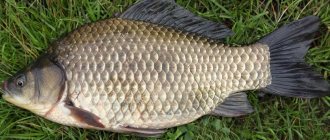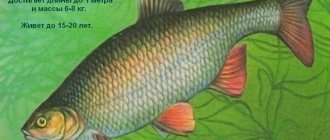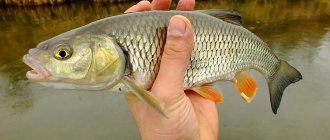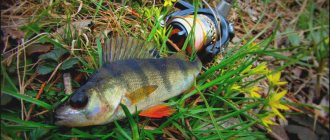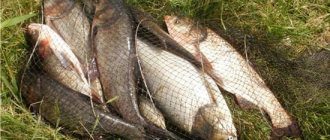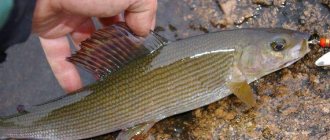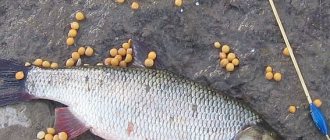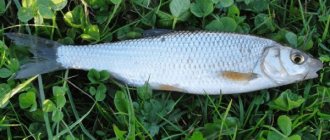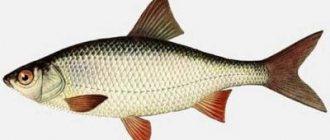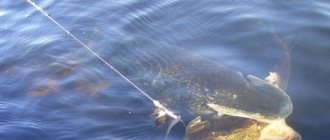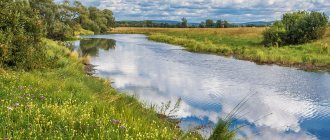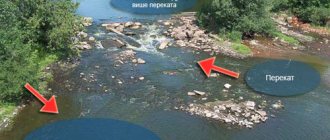How to catch silver carp
Silver carp can be classified as a fish that lives in schools and does not reproduce in our country, given the climatic conditions. The fish uses microscopic algae as food, or otherwise called phytoplankton. In order to catch a good catch, you need to go fishing in June, August and the very beginning of September. The catch of silver carp is not affected by weather conditions, but only by a sharp jump in pressure. Taking into account my many years of experience as a fisherman, I will tell you in detail all the features and nuances of catching this fish.
Silver carp fishing depending on the time of year
Fishing in spring. In early spring, when there is little vegetation in the reservoir, silver carp prefers to feed on detritus (dead organic matter) and stay at depth. Appears on the surface occasionally.
Fishing rods/spinning rods
Baits/Lures
Reels
Immediately before spawning (when the water warms up), silver carp begins to feed very actively and often takes any bait. It’s not uncommon for fishermen to catch fish using chewing gum, foam rubber, etc.
You can determine the location of fish in early spring by the presence of signs of silver carp. It is not uncommon for him to jump out of the water, especially if he is scared. This fish is schooling, so if you catch one individual you can count on another trophy.
Fishing in summer. With the arrival of summer, silver carp become less interested in artificial baits, and a large amount of their usual food appears. Therefore, you have to rely a lot on luck and good bait. In summer, look for places where there is vegetation and warm water. As practice shows, in the morning silver carp are a little more active, although there is no big difference. It’s just that the water is much cleaner in the morning than during the day, so try to fish in the morning.
Fishing in the fall. Silver carp is a heat-loving , so in the fall, when the water is cool, it is not actively caught. This is not the best period for fishing. In addition to all this, there is less food, and the fish begin to move further and deeper in search of it. In general, fishing is becoming more and more difficult. However, if you know the holes where silver carp are usually found, then you can successfully catch it.
In late autumn , when the fish has accumulated a sufficient amount of fat, it begins to move and filter the water, so there is a high probability that it will swallow your hook. But when the water temperature drops noticeably (about 8 degrees), the fish practically stops feeding and goes to wintering pits, where it stays until spring.
The best weather conditions for autumn fishing are warm weather and no wind.
Do not forget that you must be very quiet, because at the slightest rustle, the fish may become wary and abandon your baits or even go deeper.
Which place to choose for catching silver carp?
To catch silver carp, you need to find reservoirs where silver carp were introduced approximately 10 years ago. At the same time, take into account the circumstance in which natural nutrition is fully present in the selected reservoir. In this case, you will not receive any catch or trophy. This can be clearly determined by the water, or rather its color. There should be no green tint in the water. Catching silver carp is a process with unpredictable results, since it is impossible to predict in advance whether there will be a bite or not. As an avid fisherman, I advise you to combine fishing for silver carp with fishing for other fish, so as not to be left without a catch.
Best biting time for silver carp
Silver carp can be caught at almost any time of the year, since it does not hibernate for the winter, but the warm season is more suitable. In cooler months, this fish can be caught, only as many professional fishermen note, it is much smaller in size due to the lack of food under water (insects and crustacean-like species).
As for the weather conditions for catching silver carp, the ideal option would be complete calm with a slightly drizzling warm rain. Under such conditions, rain gives the angler camouflage when fishing, and the fish does not see it, which is very important when fishing for silver carp. Such a fish is quite cunning and can swim up to the bait, dispersing all nearby fish, but it itself will not be caught or will swim away altogether.
What equipment is needed when fishing for silver carp?
For good fishing, you should always have with you a hook, a feeder, and carp “sticks” that can withstand heavy loads. As a professional fisherman, I recommend using a two-section carp “stick” “Shimano BEASTMASTER AX Specimen 13 350 Long Range DOUBLE LEG” for catching silver carp, the length of which is almost 4 meters, and the test weight is 160 grams. In addition, I recommend the Okuma Distance Carp Pro 60 spinning reel, which is equipped with a PowerPRO line with a diameter of 0.30 mm. Keep in mind that while fishing, long casting may be necessary. In this case, installation of a “shock leader” will be required.
Choosing a fishing spot
When choosing a place for fishing, you need to know: if there is a lot of natural food in the reservoir, then there is practically no chance of catching silver carp. This circumstance can be determined visually - by color: the water should not be greenish. But in reservoirs where there is a lack of food supply, you can catch more than one large specimen.
It is better to catch silver carp on relatively small rocky rivers with sharp changes in depth. A place for fishing should be chosen based on the following criteria:
- with a rocky, clay or sandy bottom;
- with a depth of no more than four meters.
Let's move on to the most important thing, namely, the equipment for catching silver carp.

The main component of the equipment is a loaded feeder or spring, with an anti-twist. The universal weight of the feeder should be no more than 70 grams. For a leash, it is best to use a fishing line with a diameter of 0.25 mm and a length of up to 30 cm, but no more. The ideal hook would be “KOSADAKA” OTAKU 3303 Gold Size No. 6 with a wire thickness of 0.56 mm.
A little advice: using a braided leash did not justify itself, there were no bites, so you should not waste your time on it.
What to fish with

Until recently, it was believed that any equipment for catching silver carp could be chosen. But it is not so. There are certain requirements for it. But the most important thing is that it must be characterized by increased strength, since we are talking about catching fish with very strong resistance, capable of making fairly powerful throws. That is why the equipment for catching silver carp must be reliable, not torn or broken after the first fishing.
For this purpose, you can use a feeder, a hook, as well as any carp “sticks”, preferably having a good load-carrying capacity. Large specimens are quite shy and very rarely swim closer to the shore than eight or ten meters. Therefore, catching silver carp with a fishing rod is very rare, because the latter must have an impressive length and the ability to cast as accurately as possible, which is not typical for this tackle. However, often when fishing for carp, he himself falls for it.
How to lure silver carp while fishing?

The most favorite bait of silver carp is well-cooked peas. In my practice, I only use this cereal. To properly prepare the bait, you need to cook the peas until completely softened, or rather until pureed. To prevent the resulting mass from flowing off the feeder, it is worth using breadcrumbs for this purpose. To ensure that the bait does not deteriorate during fishing, given the fact that the grain quickly deteriorates, it is necessary to store it in a cool place. With proper storage of bait, fishing will certainly not be without a catch.
For silver carp bait, I recommend using large polystyrene foam, preferably white and up to 8 mm in diameter. In this case, the buoyant properties of the foam are very important, which should be enough to tear the hook and leash a few centimeters from the bottom. If such a situation is missed, then there is no need to deploy the cage.
Recipes for bait for silver carp
Bait can consist of a wide variety of ingredients, so when preparing it, fishermen use their imagination and often experiment. But it is important to observe moderation in supplements. Since an excess of aromas, as well as the use of unpleasant or unappetizing components for silver carp, can scare away the fish. To avoid bad experiences, we offer the following recipes for preparing bait with your own hands, the effectiveness of which has been proven over the years.
Groundbait with pea base
Ingredients:
- yellow peas – 1 kg;
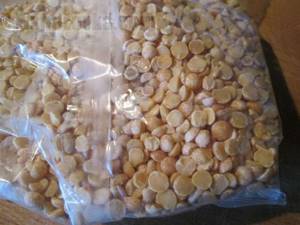
Photo 2. Ordinary peas for soup or puree.
- soda – 1 tbsp. l.;
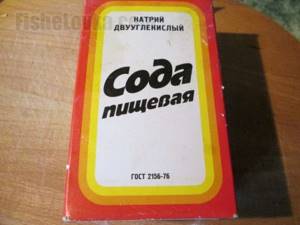
Photo 3. Every housewife has soda.
- semolina – 2 kg;
- honey – 1 tbsp. l.
In a large saucepan, at least 5 liters, it is necessary to heat the water until hot, but not to a boil, and pour 1 kg of premium yellow peas into it. Peas can burn and boil over quickly, so it's best to keep an eye on them while stirring. As soon as it boils, add a tablespoon of soda and place on low heat. Next, wait until the peas are completely boiled, on average this takes about three hours.
If you don’t want to wait until the peas are completely boiled, you can do this. At a certain stage, the resulting puree must be rubbed through a sieve, since then you will only need porridge without solid particles. Place it on the stove again, and after boiling, begin to gradually add semolina, stirring regularly to avoid the formation of lumps.
Advice! Be careful not to burn the peas. Silver carp will never respond to the slightest smell of burning. And also thoroughly knead the bait to prevent the formation of lumps and clots.
Next, remove the semi-finished product from the heat and continue adding semolina, as well as active mixing, until a dough-like mass is obtained. It must be placed on a surface previously sprinkled with semolina and kneaded until the dough stops sticking to your hands.
Then melt the honey in a water bath and add it to the resulting dough. For better mixing, you can divide the dough into parts, adding honey and kneading each separately. The finished product is enough for several trips to the pond. Temporarily unnecessary bait is stored in the refrigerator.
What time to catch silver carp
The best bite for silver carp is in the morning and lunchtime. In my experience, this statement is true. But at night, it was never possible to catch a trophy from a reservoir. It is necessary to cast correctly, taking into account that the tackle must lie on a clean bottom. The largest representatives of silver carp are quite shy, so it is recommended to cast them as far from the shore as possible. The bait's maximum effect on silver carp lasts approximately several hours. This circumstance forces you to reload and throw it again after a certain time. In silver carp fishing, the main thing is to gain experience, and then it will become commonplace for you.
Where to fish
This representative of the carp family can live both in large and medium-sized rivers, and in large standing reservoirs. It is unlikely to be caught in the very rapids of the river, where the main food of silver carp - phytoplankton - is absent. River bays and oxbow lakes are abundantly populated with small aquatic organisms, where you should look for this fish. You should not catch silver carp at a depth of less than 2 m, as it is very careful and rarely goes into shallow water.
On a note! In stagnant reservoirs, silver carp are evenly distributed throughout the entire water area, but they gravitate more towards areas where rivers flow into the reservoir, since in such places there is a high concentration of plankton.
In lakes and reservoirs, individuals weighing up to a kilogram can more often be found in coastal waters, while more substantial specimens prefer to feed in areas remote from the shore.

When fishing for silver carp, it is advisable to use several rods at once.
Silver carp is a heat-loving fish and begins to show feeding activity only after the water warms up to 12 degrees. In spring, its capture is more likely in areas with depths of 2–3 m.
In summer, it can be caught in places with a depth of 4–7 m. In September, silver carp still adheres to summer habitats, but by the end of the month it sinks into the middle layers of water and rolls down to deeper areas. It becomes quite difficult to catch silver carp in October, since at this time it sinks into the bottom layers and moves closer to the wintering pits. In winter, this fish settles in deep holes littered with snags and is caught randomly on fishing gear.
How to catch silver carp on a donk?

You won’t believe it, but my very first tackle at the initial stage of professional fishing for this type of fish was the “silver carp stick.” I saw this method in a video, so I decided to try it and put it into practice. The design of the tackle provides for absolutely all the nuances of the structure of the silver carp’s oral cavity, as well as the peculiarities of its feeding.
Technoplankton acts as bait, bait and bait. It is a product specially designed for catching different types of fish, including silver carp. Its shape resembles a “barrel”, in which there is compressed bait, and along the axis there is a small hole for fastening.
To catch silver carp, you should choose light-colored technoplankton. When buying a package, pay attention to what fish it is intended for: carp, grass carp, catfish, silver carp. My choice was only for the fish we were considering. Keep in mind that technoplankton tends to get wet, especially in stagnant water, in 30–40 minutes. If fishing takes place on a river, then getting wet happens much faster.
Where are silver carp found?
Silver carp is a fish belonging to the carp family. It lives in freshwater bodies mainly in flocks.
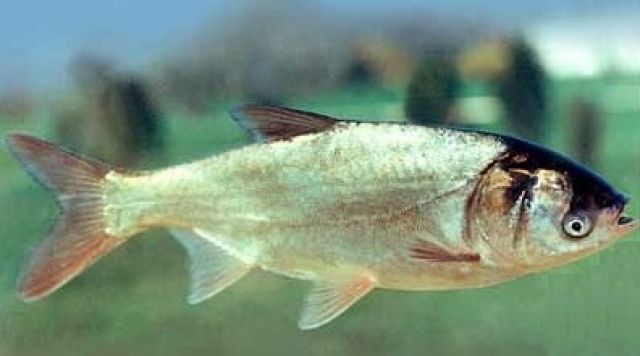
Appearance of silver carp
This fish is found in rivers, lakes and ponds. Silver carp is very thermophilic and prefers well-warmed areas of reservoirs with standing water. The best time of year for fishing is the summer months and early autumn. It is found at the average depth of the reservoir and feeds mainly on phytoplankton.
What gear should I use to catch silver carp on top?

If you notice that a silver carp is swimming on top in order to feed, then the bait should be presented so that it can float exclusively on the surface of the water. For these purposes, use a water-filled ball or Sbirulino float, as well as a leash of invisible fishing line up to 0.3 mm thick and 1.5 m long. When choosing an attachment for fishing on a float and on top, take into account what the silver carp is fed in the pond, if it is private.
In my opinion, it is better in this option to use bread crumb, bread crust, and, if possible, canned corn. I do not recommend rolling the bread crumb into a ball when attaching it to the hook. Use a simple method - lightly press the bread with your fingers, this will be enough. This is because on the hook the bread should take on a soft, softened and fluffy appearance.
If you use bread as a bait for fishing on top, I recommend:
- use soft French loaves, which should be pierced several times during planting. The first puncture should be from the flesh side, then lift the hook up and turn it so that the tip of the hook is turned down onto the crust, and only then repeat the puncture. In this version, the crust is much better fixed on the hook when casting.
- Keep in mind that the size of the crust should be medium, not small. This is due to the fact that while the silver carp gets to the bait, the crust will be gnawed off by small fish such as rudd, crucian carp, and roach.
Taking into account many years of experience as a fisherman, I can safely say that catching silver carp with float gear on top was very rare and caused a lot of trouble. The finished catch of silver carp in this way was only 2 kilograms, but it was not possible to get a catch as a large fish until I found another solution, using a floating nozzle with bait.
Bait for silver carp
Silver carp, like all carp fish, loves:
- fragrant black bread crumb;
- peas;
- anise.
Many anglers catch large silver carp using bread balls or pea porridge. Both ready-made purchased mixtures for silver carp or carp fish, as well as home-prepared ones, can serve as bait. When preparing bait, it should be taken into account that fish react mainly to the smell and color of the bait. It would be useful to add:
- vegetable oil;
- anise;
- a little red food coloring (to add color);
- bread crumb;
This will help the fish notice the bait faster and swim to the place where it was caught.
How to catch silver carp with a float rod?

I managed to catch the very first silver carp thanks to the universal carp tackle for long-distance casting. In this option, it is necessary to take into account the correctly selected float, which must be transparent. Regular floats scare away silver carp. Remember that you need to go deeper, although the fish can be no deeper than 15 cm from the surface.
If the pond you choose contains all kinds of sticks or reeds, you should use balsa floats. But, there is one nuance that needs to be taken into account. The float with the antenna should not be positioned vertically. The silver carp will be wary if the float you have chosen stands out among the various branches that are located in a horizontal position, and thus will scare off our object. I recommend securing it so that it is in horizontal visibility.
I always use several float options for catching silver carp.
- A float that has an oblong appearance, made of polystyrene foam and surrounded at the bottom with a couple of pellets. The uppermost part of it is painted in a bright color shade, but the bottom is protective. It may not necessarily be the color of the water. Since the fish looks at the food from below from the reservoir, and all objects seem blue to it, so I choose the bottom of the float of a bluish tint. It wouldn't hurt to use gray and white floats.
- Universal floats in which the antenna is slightly visible, and where the fishing line must be passed through the cambric on the antenna. It is worth loading so that they do not stand up, but are on the surface of the water.
These tips and recommendations will help novice fishermen in catching a worthy trophy in the form of silver carp fish.
Rod and fishing rod equipment
Silver carp are mainly a diurnal fish and bite from early morning until noon. Based on these characteristics, it is worth selecting the appropriate equipment for the fish.
Read more about the correct equipment of a float fishing rod in a special article.
The general diagram of the equipment of any float fishing rod in the figure:

Please note in the left picture below the sinker pellets there is a carabiner that connects the main fishing line with a leash, which is thinner in diameter and serves to camouflage the fishing line so as not to spook the fish with the equipment. You can find out how to tie a leash to the main line here.
Attention! It is very important that the float is loaded correctly. The entire body of the float should be recessed under the water, and only the plastic/wooden tip should be visible above the water. If the barrel is visible above the surface, then add weights to the line.
About how to make float equipment for silver carp. Helpful tips:
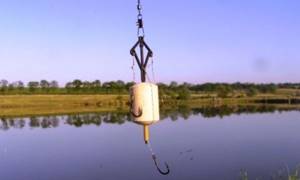
technoplankton has proven itself well - an attractive bait for carp fish species. This is a specially created product for this type of fish. It is a small barrel with a recess for fastening. For silver carp, it is light blue in color.
The video describes this type of silver carp fishing:
Choosing bait and bait
To successfully catch a silver carp, you should attract its attention by creating those very cloudy spots in the water, which it will consider a source of food. Special baits will help with this. They can be purchased at a fishing store, but you can make them yourself.
The best bait will be considered to be the one that, with slight fluctuations in the water, will rise and create a cloudy cloud. The composition of such bait is quite simple: it should be based on any porridge, into which one of the listed ingredients should be added:
What does a silver carp look like?
- semolina;
- Wheat flour;
- powdered milk;
- bran;
- vanillin.
Despite the planktonic nature of the fish's diet, it is very good to add something larger to the bait, for example, bloodworms or maggots.
An alternative to porridge is pea puree. So that it can be placed in the feeder, it is recommended to mix it with some solid fraction, for example, breadcrumbs.
The use of various flavor enhancers is not recommended. In this case, the fish will filter out all the tastiest things and will not pay any attention to the bait.
The most unpleasant thing in the process of complementary feeding is that silver carp can have individual taste preferences. If he does not like the composition of the bait, then in the future he will not show any interest in similar bait.
And also do not forget that the abundance of food has a negative effect on the bite. A fish overfed with complementary foods can easily disappear for several days when it is full.
The bait for silver carp can be:
- boiled or canned peas;
- small pieces of fruit pulp;
- crushed seaweed;
- diced vegetables;
- bloodworm.

According to fishermen, using bloodworms as bait is the most preferable.
Features of behavior
The main feature of the silver carp's life cycle is its feeding method. It is he who determines all the behavior of the fish. Unlike many representatives of the aquatic world that live in our latitudes, silver carp does not consume plant or large animal food.
The oral apparatus of the silver carp is designed in such a way that it is able to filter water containing microorganisms. Its main food is detritus and microscopic algae or phytoplankton. Some species, for example, bighead carp, also consume zooplankton. Therefore, silver carp are considered to be a kind of ameliorators of reservoirs.
It is believed that the chances of catching a silver carp are practically non-existent if there is too much natural food in its habitat. Consequently, if the water in a reservoir has a pronounced greenish tint, then, figuratively speaking, “there is nothing to catch there.”
The fish prefers places that are rich in silt and vegetation. Most often, silver carp feed at a depth of about 3–4 meters. At the same time, the fish are interested in cloudy spots in the water created by its potential food. Seeing such a spot, the fish rushes to it and begins to filter the muddy water with its mouth.

In the morning or evening, silver carp can swim close to the shore, and during the day it sits out at great depths.
Therefore, catching silver carp during the day is extremely difficult.
Seasonality also plays an important role in the results of fishing. In spring, the fish are inactive and practically do not react to bait. A more or less stable bite begins at the end of May, when the reservoirs warm up to +15–20°C and the growth of small algae begins.
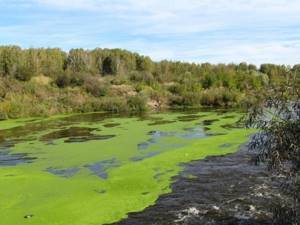
In mid-summer, the water bodies begin to “bloom,” and the fish also react poorly to bait, being content with the abundance of natural food.
With the advent of cold weather in the second half of September, the bite also almost immediately disappears. Thus, the most successful time for catching silver carp is June or the end of August - beginning of September.
